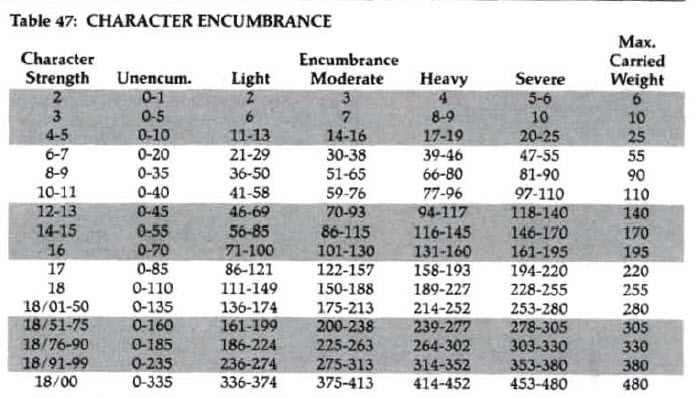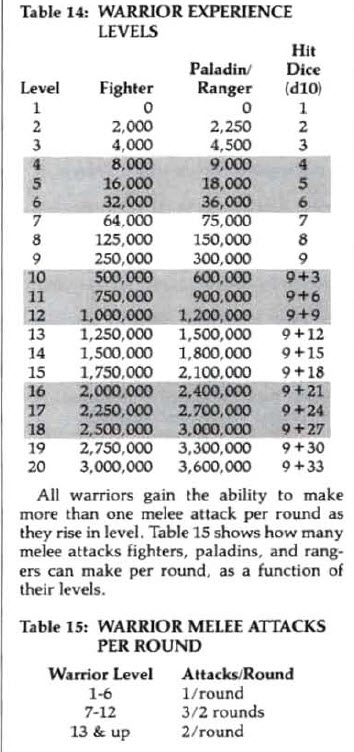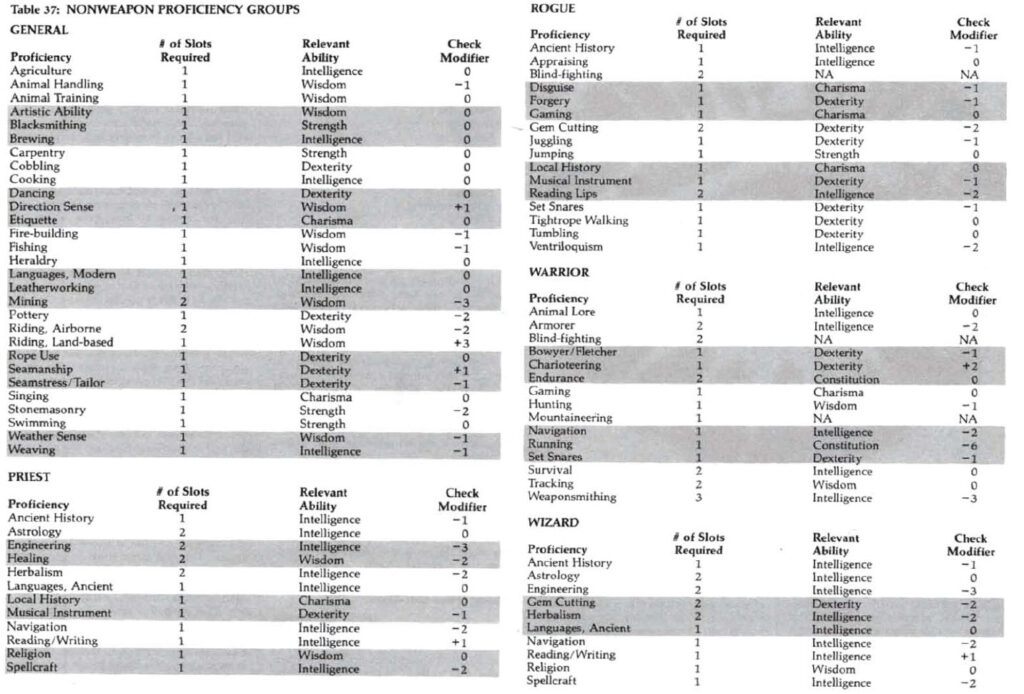
Ability
Any of the six natural traits that represent the basic definition of a player character: Strength, Dexterity, Constitution, Intelligence, Wisdom, and Charisma. A player character's abilities are determined at the beginning of a game by rolling 6-sided dice (d6s). The scores continue to be used throughout the game as a means of determining success or failure of many actions.
Ability check
A 1d20 roll against one of your character's ability scores (modifiers may be added to or subtracted from the die roll). A result that is equal to or less than your character's ability score indicates that the attempted action succeeds.
AC
Abbreviation for Armor Class.
Alignment
A factor in defining a player character that reflects his basic attitude toward society and the forces of the universe. Basically there are nine categories demonstrating the character's relationship to order vs. chaos and good vs. evil. A player character's alignment is selected by the player when the character is created.
Area of effect (AoE)
The area in which a magical spell or a breath weapon works on any creatures unless they make a saving throw.
Breath Weapon AoE
Various creatures in the AD&D game possess breath weapons, the most memorable being the roaring gout of flame spewed out by a red dragon. These weapons normally affect a cone-shaped area. One point is the dragon's mouth (obviously) and the breath widens as it extends outward. No attack roll is required for a breath weapon. All characters and creatures within the area of effect must make the appropriate saving throw and suffer the consequences of a successful breath attack.
Creatures with breath weapons cause 1d8 points of damage per Hit Die unless otherwise noted. Thus, an 8 HD dragon would cause 8d8 points of damage with its breath. Fortunately for player characters, the powerful attacks of such creatures have a limited number of uses per day!
Grenade-Like AoE
Most grenade-like missiles are items of opportunity or necessity - flasks of oil, vials of holy water, or beakers of acid, for example. As such, these items are not listed on the equipment tables for range, ROF, and damage. The range each can be thrown varies with the Strength of the character and the weight of the object.
A missile of five pounds or less can be thrown about 30 feet. Short range is 10 feet, medium range is 20 feet, and everything beyond is maximum range. Heavier items have reduced ranges. Just how far they can be thrown is decided by the DM.
Exceptionally heavy items can be thrown only if the character is exceptionally strong - bars/lift gates check. In no case can a character throw an item heavier than his Strength would allow. If it is a solid flask, the DM can rule that a character would have difficulty throwing it as far as a lighter object. If a container hits and does not break, it bounces and rolls to a stop, possibly in the faces of his orcish friends.
Once a container hits, it normally breaks immediately. However, this is not always true. Some missiles, like soft leather flasks or hard pottery, are particularly resistant. If there is some doubt about whether or not a thrown object will break, the DM can require an item saving throw, or he can just see if it shatters or rips, spewing its contents everywhere.
If a missile is off-target, it is important to know where it landed - an errant grenade that missed could present a hazard to the characters, as it falls through a roof or lands on the floor. The process of finding where it lands is known as scatter. First roll 1d10 and consult the Scatter Diagram.

Next determine how far off the mark the throw is. If the throw is at short range, use a 6-sided die. If the range is medium, use a 10-sided die. If thrown to long range, roll 2d10. The number rolled is the number of feet away from the intended target the missile lands.
When the grenade-like missile lands, the DM checks damage on whether a direct hit was obtained and what type of area of effect damage was caused. Damage is often listed as 1d4 damages from direct and splash hits. The Area of Effect of a grenade-like missile covers a 3' diameter. Any creature in the area of effect will take damage according to the type of hit it received. All creatures within 3' of the area of effect are subject to splash damage.
Types of Grenade-Like Missiles
Acid damage is particularly grim. Aside from the damage caused by the initial hit, further damage can be inflicted by DM, at a random rate. Acid damage must be healed normally. It is very useful against regenerating creatures such as trolls. Acid is very rare.
Holy water affects undead and creatures from other planes. It has no effect on most other creatures. Holy water causes a damage of 2d4 hp to most undead and can also be used to damage certain evil creatures.
Oil usually affects only materials flammable. Holy oil usually only affects creatures from other planes and can affect creatures of opposing alignments.
Oil causes damage when hit. It is ignited for damage by one of three means: a torch, a burning fuse, or magical fire. It can be used to start large fires. Thrown oil covers a 3' diameter and causes a fire that burns for 1d6 rounds.
Poison weapon. Most poisons take effect when they come into contact with flesh. A poison only inflicts damage on the target if it drops into the gaping maw of some unsuspecting creature. Contact poisons have normal poison effects on a direct hit.
Table 45: GRENADE-LIKE MISSILE EFFECTS
| Type of Missile | Area of Effect | Direct Hit | Splash Damage |
|---|---|---|---|
| Acid | 1' diameter | 2-8 hp | 1 hp |
| Holy Water | 1' diameter | 2-7 hp | 2 hp |
| Oil (lit) | 3' diameter | 2-12/1-6 hp | 1-3 hp |
| Poison | 1' diameter | special | - |
Armor Class (abbr. AC)
A rating for the protective value of a type of armor, figured from 10 (no armor at all) to 0 or even -10 (the best magical armor). The higher the AC, the more vulnerable the character is to attack.
Attack roll
The 1d20 roll used to determine if an attack is successful.
Bend bars/lift gates roll
The roll of percentile dice to determine whether a character succeeds in bending metal bars, lifting a heavy portcullis, or similar tasks. The result needed is a function of Strength and can be found in Table 1.

Bonus spells
Extra spells at various spell levels that a priest is entitled to because of high Wisdom; shown in Table 5.

Breath weapon
The ability of a dragon or other creature to spew a substance out of its mouth just by breathing, without making an attack roll. Those in the area of effect must roll a saving throw.
Cha
Abbreviation for Charisma.
Chance of spell failure
The percentage chance that a priest spell will fail when cast. Based on Wisdom, it is shown in Table 5.

Chance to know spell
The percentage chance for a wizard to learn a new spell. Based on Intelligence, it is shown in Table 4.

Charisma (abbr. Cha)
An ability score representing a character's persuasiveness, personal magnetism, and ability to lead.
Class
A character's primary profession or career.
Common
The language that all player characters in the AD&D game world speak. Other languages may require the use of proficiency slots.
Con
Abbreviation for Constitution.
Constitution (abbr. Con)
An ability score that represents a character's general physique, hardiness, and state of health.
Critical Hit
A critical hit occurs when a player rolls a natural 20 on a 20-sided die during an attack roll. This signifies an especially successful attack, often resulting in additional damage or other beneficial effects as determined by the Dungeon Master. The exact rules for critical hits can vary, so players should consult their specific campaign rules or the Dungeon Master for details.
Critical Failure
A critical failure, sometimes referred to as a "fumble," occurs when a player rolls a natural 1 on a 20-sided die during an attack roll. This signifies a particularly poor or unfortunate attack, often resulting in a negative consequence such as dropping a weapon, harming oneself, or other detrimental effects as determined by the Dungeon Master. Like critical hits, the specifics of critical failures can vary by campaign.

d
Abbreviation for dice or die. A roll that calls for 2d6, for example, means that the player rolls two six-sided dice.
d3
Since there is no such thing as a three-sided die, a roll calling for d3 means to use a d6, making 1 and 2 be a 1, 3 and 4 be a 2, and 5 and 6 be a 3.
d4
A four-sided die.
d6
A six-sided die.
d8
An eight-sided die.
d10
A ten-sided die. Two d10s can be used as percentile dice.
d12
A twelve-sided die.
d20
A twenty-sided die.
d100
Either an actual 100-sided die or two different-colored ten-sided dice to be rolled as percentile dice.
DMG
A reference to the Dungeon Master Guide.
Damage
The effect of a successful attack or other harmful situation, measured in hit points.
Demihuman
A player character who is not human: a dwarf, elf, gnome, half-elf, or halfling.
Dex
Abbreviation for Dexterity.
Dexterity (abbr. Dex)
An ability score representing a combination of a character's agility, reflexes, hand-eye coordination, and the like.
Dual-class character
A human who switches character class after having already progressed several levels. Only humans can be dual-classed.
Encumbrance
The amount, in pounds, that a character is carrying. How much he can carry and how being encumbered affects his movement rate are based on Strength and are shown in Tables 47 and 48. Encumbrance is an optional rule.


Energy drain
The ability of a creature, especially undead, to drain energy in the form of class levels from a character, in addition to the normal loss of hit points.
Experience points (abbr. XP)
Points a character earns (determined by the Dungeon Master) for completing an adventure, for doing something related to his class particularly well, or for solving a major problem. Experience points are accumulated, enabling the character to rise in level in his class, as shown in Table 14 for warriors, Table 20 for wizards, Table 23 for priests, and Table 25 for rogues.




Follower
A nonplayer character who works for a character for money but is initially drawn to his reputation.
Gaze attack
The ability of a creature, such as a basilisk, to attack simply by making eye contact with the victim.
Henchmen
Nonplayer characters who work for a character mainly out of loyalty and love of adventure. The number of henchmen a character can have is based on Charisma and is shown in Table 6. The DM and the player share control of the henchmen.

Hireling
Nonplayer characters who work for a character just for money. Hirelings are completely under the control of the DM.
Hit Dice
The dice rolled to determine a character's hit points. Up to a certain level, one or more new Hit Dice are rolled each time a character attains a new class level. A fighter, for example, has only one 10-sided Hit Die (1d10) at 1st level, but when he rises to the 2nd level, the player rolls a second d10, increasing the character's hit points.
Default monster Hit Dice (HD) is 1d8, so if you see a monster with Hit Dice 3, means that monster has up to 24 hit points, or 3d8.
Hit points
A number representing: 1. how much damage a character can suffer before being killed, determined by Hit Dice. The hit points lost to injury can usually be regained by rest or healing; 2. how much damage a specific attack does, determined by weapon or monster statistics, and subtracted from a player's total.
Infravision
The ability of certain character races or monsters to see in the dark. Infravision generally works up to 60 feet in the darkness.
Initiative
The right to attack first in a combat round, usually determined by the lowest roll of a 10-sided die. The initiative roll is eliminated if surprise is achieved.
Int
Abbreviation for Intelligence.
Intelligence (abbr. Int)
An ability score representing a character's memory, reasoning, and learning ability.
Italic type
Used primarily to indicate spells and magical items.
Level
Any of several different game factors that are variable in degree, especially: 1. class level, a measure of the character's power, starting at the 1st level as a beginning adventurer and rising through the accumulation of experience points to the 20th level or higher. At each level attained, the character receives new powers. 2. spell level, a measure of the power of a magical spell. A magic-using character can use only those spells for which his class level qualifies him. Wizard spells come in nine levels (Table 21); priest spells in seven (Table 24).


Loyalty base
A bonus added to or a penalty subtracted from the probability that henchmen are going to stay around when the going gets tough. Based on the character's Charisma, it is shown in Table 6.

M
Abbreviation for material component.
Magical defense adjustment
A bonus added to or a penalty subtracted from saving throws vs. spells that attack the mind. Based on Wisdom, it is shown in Table 5.

Maneuverability class
A ranking for flying creatures that reflects their ability to turn easily in aerial combat. Each class-from a top rank of A to a bottom rank of E-has specific statistical abilities in combat.
Material component (abbr. M)
Any specific item that must be handled in some way during the casting of a magical spell.
Maximum press
The most weight a character can pick up and raise over his head. It is a function of Strength and may be found in Table 1.

Melee
Combat in which characters are fighting in direct contact, such as with swords, claws, or fists, as opposed to fighting with missile weapons or spells.
Missile combat
Combat involving the use of weapons that shoot missiles or items that can be thrown. Because the combat is not "toe-to-toe," the rules are slightly different than those for regular combat.
Movement rate
A number used in calculating how far and how fast a character can move in a round. This number is in units of 10 yards per round outdoors, but it represents 10 feet indoors. Thus, an MR of 6 is 60 yards per round in the wilderness, but only 60 feet per round in a dungeon.
MR
Abbreviation for movement rate.
Multi-class character
A demihuman who improves in two or more classes at the same time by dividing experience points between the different classes. Humans cannot be multi-classed.
Mythos (pl. mythoi)
A complete body of belief particular to a certain time or place, including the pantheon of its gods.
Neutrality
A philosophical position, or alignment, of a character that is between belief in good or evil, order or chaos.
Nonhuman
Any humanoid creature that is neither a human nor a demihuman.
Nonplayer character (abbr. NPC)
Any character controlled by the DM instead of a player.
NPC
Abbreviation for nonplayer character.
Open doors roll
The roll of a 20-sided die to see if a character succeeds in opening a heavy or stuck door or performing a similar task. The die roll at which the character succeeds can be found in Table 1.

Opposition school
A school of magic that is directly opposed to a specialist's school of choice, thus preventing him from learning spells from that school, as shown in Table 22.

PC
Abbreviation for player character.
Percentage (or percent) chance
A number between 1 and 100 used to represent the probability of something happening. If a character is given an X percentage chance of an event occurring, the player rolls percentile dice.
Percentile dice
Either a 100-sided die or two 10-sided dice used in rolling a percentage number. If 2d10 are used, they are of different colors, and one represents the tens digit while the other is the ones.
Player Character (abbr. PC)
The characters in a role-playing game who are under the control of the players.
Poison save
A bonus or a penalty to a saving throw vs. poison. Based on Constitution, it is shown in Table 3.

Prime requisite
The ability score that is most important to a character class; for example, Strength to a fighter.
Proficiency
A character's learned skill not defined by his class but which gives him a greater percentage chance to accomplish a specific type of task during an adventure. Weapon and nonweapon proficiency slots are acquired as the character rises in level, as shown in Table 34. The use of proficiencies in the game is optional.

Proficiency check
The roll of a 20-sided die to see if a character succeeds in doing a task by comparing the die roll to the character's relevant ability score plus or minus any modifiers shown in Table 37 (the modified die roll must be equal to or less than the ability score for the action to succeed).

A Proficiency Check determines if a character succeeds in performing a specific action, such as climbing or swimming. This check typically involves rolling a 20-sided die (d20) and comparing the result to the character's relevant ability score (Strength, Dexterity, etc.) modified by any bonuses or penalties associated with their proficiency.
For example, if a character is attempting to climb a slippery surface, they would make a proficiency check using their Climbing skill, adjusted for any difficulty modifiers. The document outlines specific scenarios and the associated checks:
Tightrope Walking:
- Surface Width Modifiers:
- 1 inch or less: -10 penalty
- 2 to 6 inches: -5 penalty
- 7 to 12 inches: no penalty
- More than 1 foot: no check needed
- Other Modifiers:
- Using a balancing rod: reduces penalties by 2
- Winds or vibrations: increases penalties by 2 to 6
- Combat on a Tightrope:
- Attack rolls suffer a -5 penalty
- Proficiency check required each round to maintain balance
Scaling a Wet Wall:
- Relevant Ability: Dexterity
- Modifiers: -4 penalty for the wet surface
- Roll: d20
- Success: Roll is equal to or less than Dexterity - 4
Walking Over a River on a Log:
- Relevant Ability: Dexterity
- Modifiers: -5 penalty for narrow log, additional penalties for wind or vibration
- Roll: d20
- Success: Roll is equal to or less than Dexterity - 5 (plus any additional penalties)
Swimming:
- Characters without proficiency can float but not swim
- Proficient swimmers can move according to the rules in the "Swimming" section (Chapter 14: Time and Movement)
Tracking:
- Non-rangers: -6 penalty to ability scores
- Rangers: no penalty
The specific proficiency and the relevant ability score define the base success rate, and additional modifiers adjust this rate based on circumstances such as surface condition, weather, and equipment used.
Examples:
- Climbing a Wet Wall:
- Use the Climbing proficiency.
- Roll a d20 and compare the result to the character's Dexterity score plus or minus any modifiers (e.g., wet surface).
- Crossing a Log Over a River:
- Use the Tightrope Walking proficiency.
- Apply the appropriate surface width modifier and roll a d20, comparing the result to the character's Dexterity score adjusted by the modifier.
Ability Checks as Saving Throws
In some cases, ability checks can replace saving throws to determine if a character avoids danger using one of their abilities. For instance, a Dexterity check might be used to dodge a falling rock .
These proficiency checks and ability checks provide a flexible system for resolving a wide range of actions and challenges in AD&D 2nd Edition.

Race
A player character's species: human, elf, dwarf, gnome, half-elf, or halfling. Race puts some limitations on the PC's class.
Rate of fire (abbr. ROF)
Number of times a missile-firing or thrown weapon can be shot in a round.
Reaction adjustment
A bonus added to or penalty subtracted from a die roll used in determining the success of a character's action. Such an adjustment is used especially in reference to surprise (shown on Table 2 as a function of Dexterity) and the reaction of other intelligent beings to a character (shown on Table 6 as a function of Charisma).


Regeneration
A special ability to heal faster than usual, based on an extraordinarily high Constitution, as shown in Table 3.

Resistance
The innate ability of a being to withstand attack, such as by magic. Gnomes, for example, have a magic resistance that adds bonuses to their saving throws against magic (Table 9).

Resurrection survival
The percentage chance a character has of being magically raised from death. Based on Constitution, it is shown in Table 3.

Reversible
Of a magical spell, able to be cast "backwards," so that the opposite of the usual effect is achieved.
ROF
Abbreviation for rate of fire.
Round
In combat, a segment of time approximately 1 minute long, during which a character can accomplish one basic action. Ten combat rounds equal one turn.
S
Abbreviation for somatic component.
Saving throw
A measure of a character's ability to resist (to "save vs.") special types of attacks, especially poison, paralyzation, magic, and breath weapons. Success is usually determined by the roll of 1d20.
School of magic
One of nine different categories of magic, based on the type of magical energy utilized. Wizards who concentrate their work on a single school are called specialists. The specific school of which a spell is a part is shown after the name of the spell in the spell section at the end of the book.
Somatic component (abbr. S)
The gestures that a spellcaster must use to cast a specific spell. A bound wizard cannot cast a spell requiring somatic components.
Specialist
A wizard who concentrates on a specific school of magic, as opposed to a mage, who studies all magic in general.
Spell immunity
Protection that certain characters have against illusions or other specific spells, based on high Intelligence (Table 4) or Wisdom (Table 5) scores.


Sphere of influence
Any of sixteen categories of priest spells to which a priest may have major access (he can eventually learn them all) or minor access (he can learn only the lower level spells). The relevant sphere of influence is shown as the first item in the list of characteristics in the priest spells.
Str
Abbreviation for Strength.
Strength (abbr. Str)
An ability score representing a character's muscle power, endurance, and stamina.
Surprise roll
The roll of a ten-sided die by the Dungeon Master to determine if a character or group takes another by surprise. Successful surprise (a roll of 1, 2, or 3) cancels the roll for initiative on the first round of combat.
System shock
A percentage chance that a character survives major magical effects, such as being petrified. Based on Constitution, it is shown in Table 3.

THAC0
An acronym for "To Hit Armor Class 0," the number that a character needs to roll in order to hit a target with AC 0.
Take character's level, their assigned THAC0, and subtract their positive Armor Class value to your THAC0, and that is what you need to equal to or roll over with a twenty-sided die 1d20.
If their Armor Class (AC) is a negative you add that to your THAC0 value and that is what you have roll equal to or above with a 1d20.
To-hit roll
Another name for attack roll.
Turn
In game time, approximately 10 minutes; used especially in figuring how long various magic spells may last. In combat, a turn consists of 10 rounds. 1 round equals 1 minute.
Turn undead
An ability of a cleric or paladin to turn away an undead creature, such as a skeleton or a vampire.

V
Abbreviation for verbal component.
Verbal component (abbr. V)
Specific words or sounds that must be uttered while casting a spell.
Weapon speed
An initiative modifier used in combat that accounts for the time required to get back into position to reuse a weapon.
Wis
Abbreviation for Wisdom.
Wisdom (abbr. Wis)
An ability score representing a composite of a character's intuition, judgment, common sense, and will power.
XP
Abbreviation for experience points. The points characters gain, that is needed, to advance another level.






